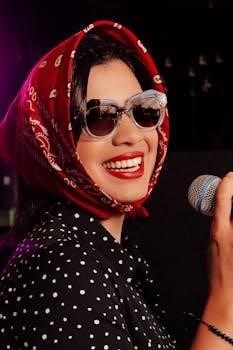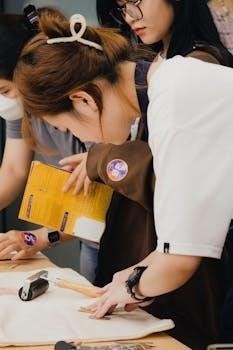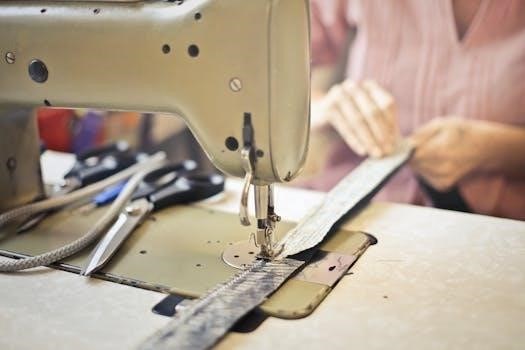
manual singer 99k
Manual Singer 99K⁚ An Overview
The Singer 99K is a vintage sewing machine, known for its reliability and compact design. These machines were produced over several decades and are valued by sewing enthusiasts today.
History and Evolution of the Singer 99K
The Singer 99K sewing machine boasts a rich history, evolving from the Singer 66. Its design was adapted for home use. Models saw changes over its production run.
Origins and Manufacturing Period
The Singer 99K emerged as a response to the demand for a more compact and portable sewing machine. Its origins can be traced back to the renowned Singer 66 model, sharing many of its mechanical underpinnings but in a smaller package. Manufacturing of the 99K spanned a significant period, commencing in the early 20th century and continuing for several decades.
Production primarily took place at Singer’s Clydebank factory in Great Britain, contributing to its widespread availability across Europe and the British Commonwealth. The extended manufacturing period allowed for various iterations and design tweaks, reflecting advancements in sewing machine technology and manufacturing processes. Consequently, identifying the specific year and factory of origin can be important for collectors.
Key Features and Design Changes Over Time
The Singer 99K is recognized for its three-quarter size, making it lighter and more portable than full-sized models. A key feature is its oscillating shuttle mechanism, known for creating a reliable stitch. Early models often featured ornate decals and a black japanned finish, reflecting the aesthetic of the era. Over time, design changes included variations in motor types, from hand-cranked to electric.
Later 99K models incorporated features like reverse stitching, enhancing their versatility. The material of certain components also evolved, sometimes reflecting cost-saving measures or material availability. Examining these subtle differences helps determine a machine’s age and production period, adding to its historical interest for collectors.
Identifying a Singer 99K
Identifying a Singer 99K involves checking the serial number and recognizing its unique features. These include its size, shape, and specific markings that distinguish it from other models.
Serial Number Lookup and Dating
Determining the age of your Singer 99K sewing machine often begins with a serial number lookup. The International Sewing Machine Collectors’ Society (ISMACS) provides resources for dating Singer machines based on their serial numbers. This lookup can reveal the year and location of manufacture, providing insight into its history.
Serial numbers are typically found on the machine’s bed or base. Inputting this number into the ISMACS database or other reliable online resources can pinpoint the production date. Knowing the manufacture date adds to the machine’s story and potential collectibility. This process helps to accurately identify and value the Singer 99K.
Distinguishing Features of the 99K Model
The Singer 99K boasts several distinguishing features that set it apart from other vintage sewing machines. One key characteristic is its three-quarter size, making it more compact and portable than full-sized models like the Singer 66. The 99K often comes in a bentwood case, enhancing its portability and protection.
Another notable feature is its oscillating hook mechanism, contributing to its reliable stitch formation. The machine’s build quality, typical of Singer’s vintage models, ensures durability and longevity. Many 99K models feature distinctive decals, adding to their aesthetic appeal. These features combined make the Singer 99K a sought-after machine for both collectors and sewing enthusiasts.

Singer 99K⁚ Common Issues and Solutions
Like any vintage machine, the Singer 99K can encounter certain common issues over time. One frequent problem is a lack of lubrication, leading to stiff operation. Regular oiling of the moving parts can resolve this. Another issue is incorrect threading, resulting in skipped stitches or tangled threads.
Consulting the original manual or online resources for proper threading techniques can help. Bobbin winding problems can also occur, often due to incorrect bobbin placement or tension issues. Adjusting the bobbin tension and ensuring correct placement usually solves this. Addressing these common issues promptly ensures the Singer 99K continues to operate smoothly and reliably.
Value and Collectibility of the Singer 99K
The Singer 99K holds value as a collectible item, influenced by its condition, rarity, and included accessories. Models in excellent working order fetch higher prices among enthusiasts.
Factors Influencing Value (Condition, Rarity, Accessories)
The value of a Singer 99K sewing machine is influenced by several factors, primarily condition, rarity, and accessories. A machine in excellent working order commands a higher price than one needing repair. Machines with original components and minimal wear are more desirable to collectors.
Rarity also plays a significant role. Certain 99K models, especially those with unique finishes or limited production runs, are highly sought after. The presence of original accessories, such as the manual, attachments, and case, further increases the machine’s value.
Complete sets are more appealing to collectors seeking a fully functional and historically accurate piece.
Price Ranges for Different 99K Models and Conditions
The price range for Singer 99K sewing machines varies widely based on the model and its condition. Machines in poor condition, needing significant repairs, may sell for as little as $50 to $130. Those in good working order, with minimal cosmetic flaws, can fetch between $65 and $200.
Exceptional models, fully restored and including original accessories and case, could command prices ranging from $150 to $280 or even higher. Rare variations, such as those with unique decals or finishes, may be valued at $200 or more.
Consider the machine’s overall presentation, functionality, and completeness when determining its value.
Accessories and Attachments for the Singer 99K
The Singer 99K sewing machine is compatible with various accessories and attachments, enhancing its versatility. These include presser feet, bobbins, and specialized tools for different sewing tasks, increasing functionality.
Commonly Available Accessories
Several accessories are commonly available for the Singer 99K sewing machine, enhancing its functionality. These include various presser feet, such as the general-purpose foot, zipper foot, and buttonhole foot, which allow for different sewing techniques. Additional bobbins are essential for efficient sewing, preventing interruptions to refill. Seam rippers aid in correcting mistakes, while screwdrivers are necessary for basic maintenance and adjustments.
Quilting guides help maintain consistent seam allowances, and edge stitchers ensure neat edges. Hemmers create professional-looking hems, and binders assist in attaching fabric edges. The availability of these accessories significantly expands the Singer 99K’s sewing capabilities, making it a versatile tool.

Maintenance and Repair of a Singer 99K
Maintaining a Singer 99K involves regular cleaning and oiling to ensure smooth operation. Addressing common mechanical issues promptly preserves its functionality and extends its lifespan, providing years of reliable service.
Basic Cleaning and Oiling Procedures
To keep your Singer 99K in optimal condition, regular cleaning and oiling are essential. Begin by removing any lint or debris from the machine’s exterior using a soft brush. Pay close attention to the bobbin area, feed dogs, and needle bar. Next, apply sewing machine oil to all moving parts, including the gears, bearings, and joints, to ensure smooth operation.
Refer to the machine’s manual for specific oiling points. After oiling, run the machine briefly to distribute the oil evenly. Wipe away any excess oil to prevent it from attracting dust and grime. Repeat this process regularly, depending on the frequency of use, to maintain the machine’s performance.

Using the Singer 99K Today
Despite its age, the Singer 99K remains a capable sewing machine. With proper maintenance, it can handle a variety of projects. Understanding its basic functions ensures enjoyable and successful sewing experiences.
Threading and Bobbin Winding
Threading the Singer 99K correctly is crucial for smooth operation. Start by placing the thread spool on the pin and guiding the thread through the tension discs. Follow the threading diagram, ensuring the thread passes through all guides before reaching the needle.
For bobbin winding, disengage the sewing mechanism. Place the bobbin on the winder spindle and guide the thread from the spool through the bobbin tensioner. Wind a consistent amount of thread onto the bobbin, avoiding overfilling. Once wound, re-engage the sewing mechanism to resume sewing. Correct threading and bobbin winding are key to preventing issues.
Singer 99K⁚ Refurbishment and Restoration
Refurbishing a Singer 99K involves a thorough cleaning, addressing any mechanical issues, and restoring its original appearance. Start by disassembling the machine and cleaning all parts with appropriate solvents to remove old oil and grime. Inspect for wear and replace any broken or damaged components.
Lubricate all moving parts with sewing machine oil. Restore the finish by carefully cleaning and polishing the exterior surfaces. Replacing decals and restoring the cabinet can enhance its value. Refurbishment extends the life and improves the performance of the Singer 99K, making it usable for years.
Where to Find Singer 99K Machines and Parts
Singer 99K machines and parts can be found in various places. Online marketplaces like eBay and Etsy are excellent sources for complete machines and individual components. Antique stores and estate sales often have vintage sewing machines, including the 99K. Local sewing machine repair shops may also carry used machines or parts.
Additionally, online forums and communities dedicated to vintage sewing machines are great resources for finding parts and connecting with sellers. Always inspect the condition of the machine or part before purchasing. Consider joining a local sewing guild for potential leads.

Singer 99K⁚ Common Problems and Solutions
Singer 99K sewing machines can experience issues due to their age. Common problems include a jammed mechanism, often caused by hardened oil or debris. Solution⁚ thoroughly clean and oil all moving parts.
Another issue is a broken or slipping belt, requiring replacement with a correctly sized belt. Tension problems can lead to skipped stitches; adjust the tension dial accordingly. A bent or damaged needle can also cause issues, so replace it with a new one.
If the motor runs but the machine doesn’t sew, check for a worn motor belt. Consult a repair professional for complex problems.


Leave a Reply
You must be logged in to post a comment.